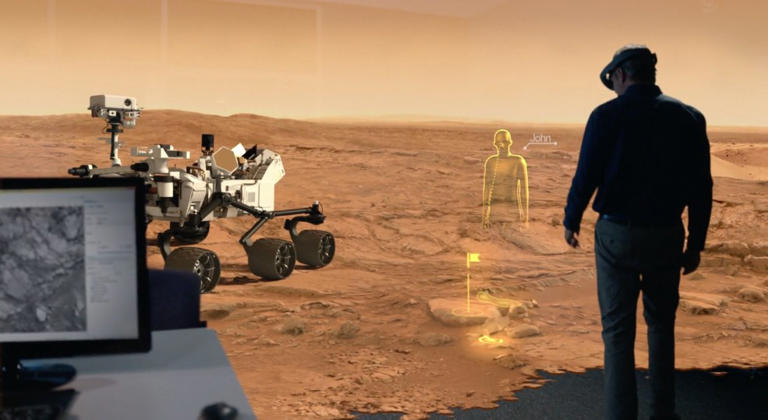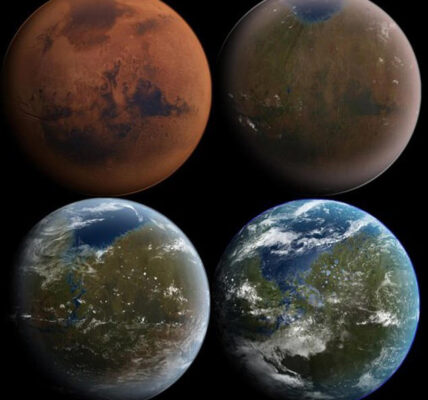Life on Mars Was Possible, scientists say, after new evidence of an ancient carbon cycle was found by NASA’s Curiosity rover in the Gale Crater, revealing that Mars once had conditions suitable for life.

Life on Mars Was Possible, New Study Finds
Life on Mars was possible, according to new scientific findings that bring us closer to understanding the Red Planet’s mysterious past. NASA’s Curiosity rover has discovered strong evidence that Mars once had a carbon cycle — a major sign that the planet might have been able to support life.
Why Scientists Are Excited About Siderite
NASA’s Curiosity rover has been exploring the Gale Crater, a 3.5-billion-year-old site believed to have once been a lake. Recently, the rover found deposits of a mineral called siderite. This is a carbon-rich mineral that forms in wet, carbon dioxide-rich environments.
The presence of siderite is a big clue that life on Mars was possible because it suggests the planet once had a thicker atmosphere. That kind of atmosphere would have been warm enough to allow liquid water to exist on the surface — one of the most important ingredients for life.
Carbon Dioxide Might Have Warmed Ancient Mars
For Mars to have flowing water, it needed a greenhouse effect — much like Earth has. Until now, scientists struggled to find enough evidence that Mars had enough CO₂ in its atmosphere to do this.
But the new discovery of siderite in the rocks shows that Mars probably did have enough CO₂ in the past. This supports the idea that life on Mars was possible, especially during a time when the planet was still relatively warm and wet.
The Disappearing Atmosphere
As the planet cooled, the CO₂ that had been warming the planet may have begun to be absorbed into the crust, forming minerals like siderite. According to Dr. Ben Tutolo, a scientist working on the Curiosity rover team, this process likely played a major role in Mars becoming cold and dry.
This change might have ended any chance for life to survive, but during the time when CO₂ was present in the air, life on Mars was possible.
Carbon: The Building Block of Life
Carbon is at the heart of all life on Earth. It cycles through the planet via processes like photosynthesis, volcanic activity, and erosion. This cycle helps regulate Earth’s temperature and makes life possible.
On Mars, scientists were hoping to find signs that a similar carbon cycle existed in the past. The layers of sediment in Gale Crater, which formed as the planet dried and cooled, have now given us that missing link. They show that carbon dioxide was indeed pulled into the rocks.
That discovery suggests life on Mars was possible, at least during a period when the carbon cycle was active.
A Global Carbon Reservoir?
What’s even more exciting is that this finding might not be unique to Gale Crater. If siderite is found in other areas of Mars as well, it could mean there was once a global carbon reservoir.
Such a thick atmosphere would have supported a more stable climate, raising the odds that life on Mars was possible in more places and for a longer time than we used to believe.
A Planet of Lost Potential?
Dr. Tutolo notes how even small changes in CO₂ can dramatically impact a planet’s ability to support life. Earth has managed to stay habitable for more than four billion years, but Mars didn’t share the same fate.
Something changed on Mars — its atmosphere thinned, its surface froze, and its potential to support life vanished. But now, thanks to these latest findings, we can say with more confidence that life on Mars was possible before these changes happened.
What’s Next for Mars Research?
If Mars once had water, warmth, and a carbon cycle — all critical for life — then it’s entirely possible that microbial life once existed there.
The challenge now is figuring out exactly how much carbon dioxide was sequestered into the Martian crust, and whether this process was widespread across the planet.
If we can answer that, we’ll know more about why life on Mars was possible in the past, but not today.
Conclusion: Life on Mars Was Possible — and That Changes Everything
The discovery of siderite in Gale Crater is a game-changer. It gives us solid proof that life on Mars was possible, and that the planet once had conditions suitable for life.
Mars may be dry and cold now, but it wasn’t always this way. And the more we learn about its past, the more we see how similar it once was to Earth. This new understanding brings us one step closer to answering one of humanity’s biggest questions: Are we alone in the universe?
Related:2024 YR4 Asteroid Impact Risk: 5 Terrifying Facts You Must Know!





The website design looks great—clean, user-friendly, and visually appealing! It definitely has the potential to attract more visitors. Maybe adding even more engaging content (like interactive posts, videos, or expert insights) could take it to the next level. Keep up the good work!
The website design looks great—clean, user-friendly, and visually appealing! It definitely has the potential to attract more visitors. Maybe adding even more engaging content (like interactive posts, videos, or expert insights) could take it to the next level. Keep up the good work!
The website design looks great—clean, user-friendly, and visually appealing! It definitely has the potential to attract more visitors. Maybe adding even more engaging content (like interactive posts, videos, or expert insights) could take it to the next level. Keep up the good work!
The website design looks great—clean, user-friendly, and visually appealing! It definitely has the potential to attract more visitors. Maybe adding even more engaging content (like interactive posts, videos, or expert insights) could take it to the next level. Keep up the good work!
The website design looks great—clean, user-friendly, and visually appealing! It definitely has the potential to attract more visitors. Maybe adding even more engaging content (like interactive posts, videos, or expert insights) could take it to the next level. Keep up the good work!
The website design looks great—clean, user-friendly, and visually appealing! It definitely has the potential to attract more visitors. Maybe adding even more engaging content (like interactive posts, videos, or expert insights) could take it to the next level. Keep up the good work!